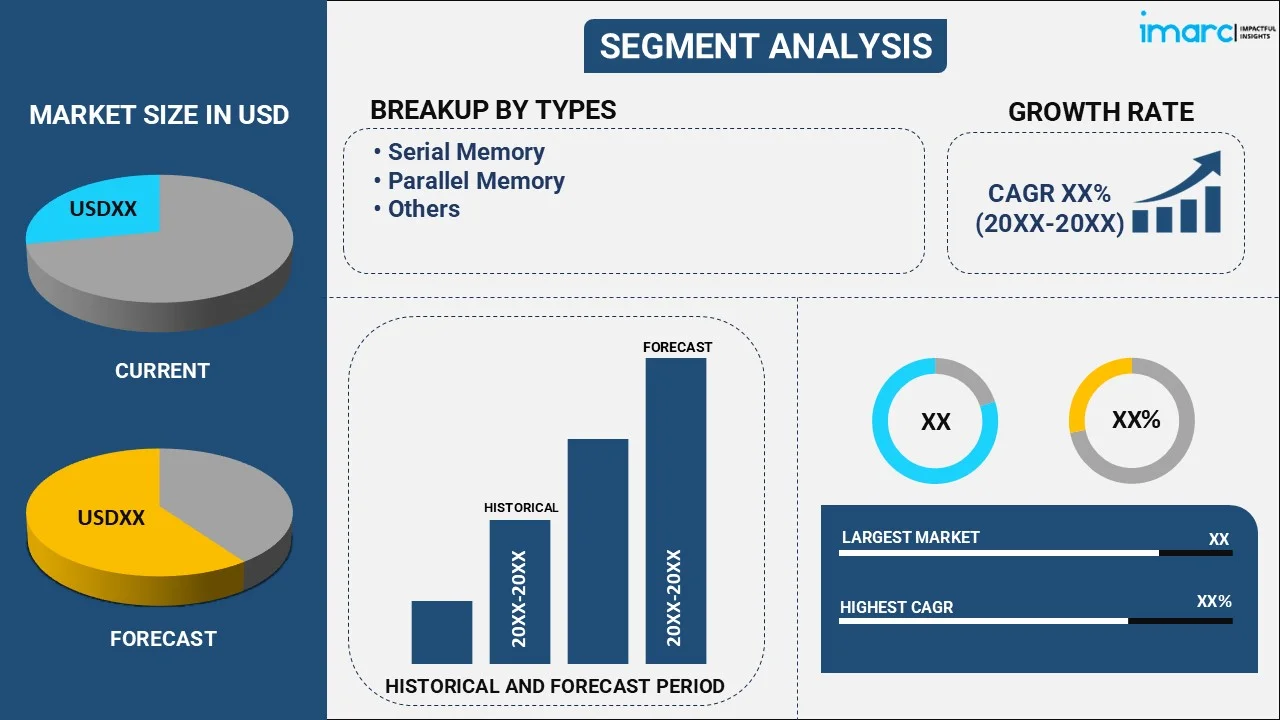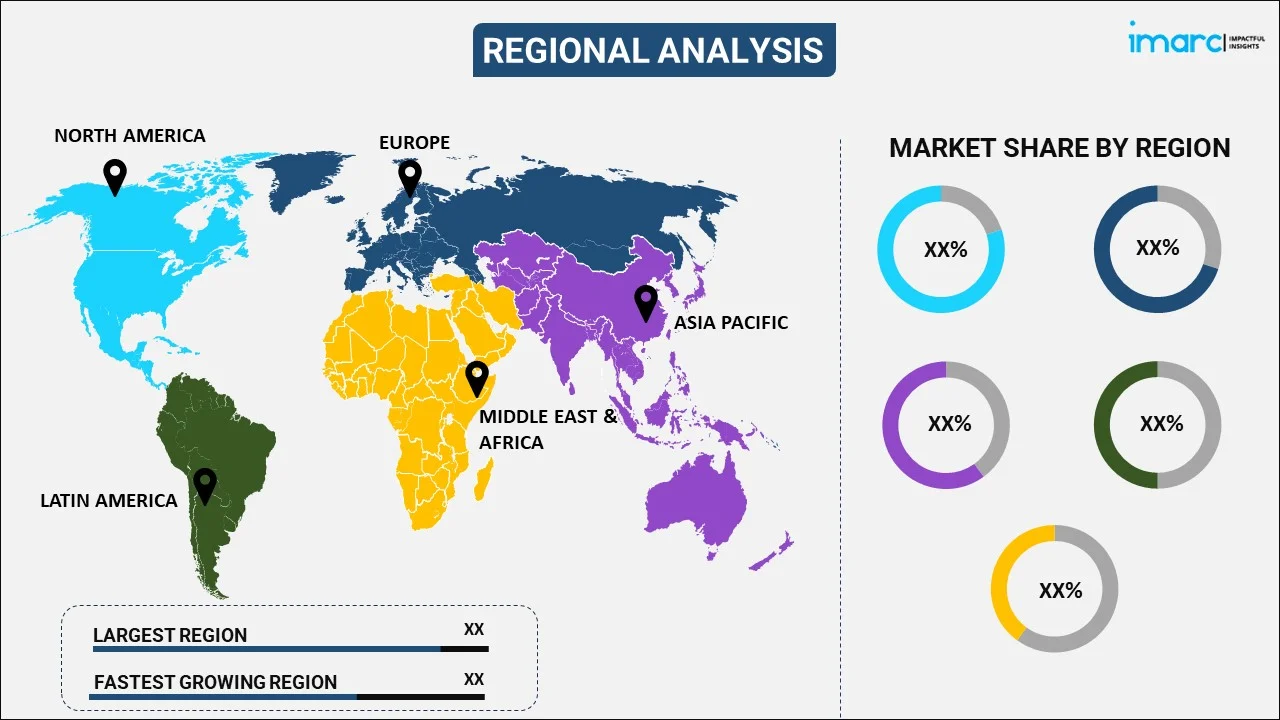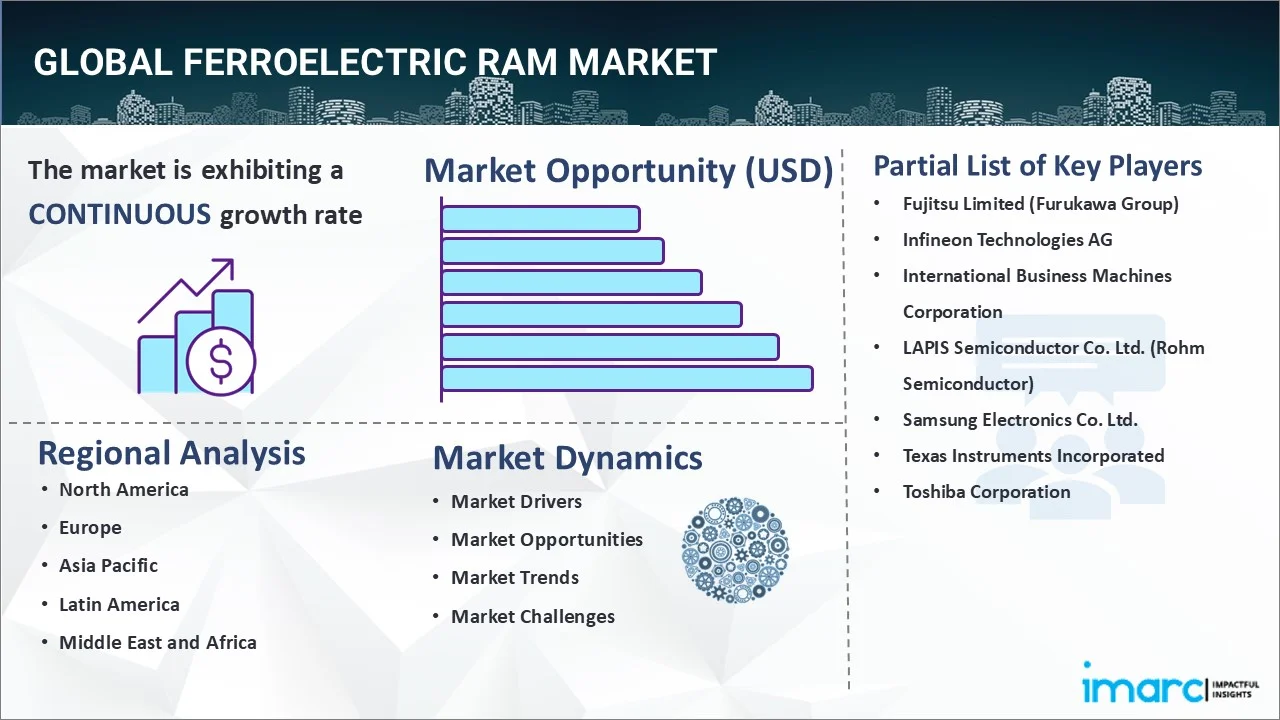
Ferroelectric RAM Market Report by Type (Serial Memory, Parallel Memory, and Others), Application (Mass Storage, Embedded Storage, and Others), End Use (Security Systems, Energy Meters, Smart Cards, Consumer Electronics, Wearable Electronics, Automotive Electronics, and Others), and Region 2025-2033
Global Ferroelectric RAM Market:
The global ferroelectric RAM market size reached USD 333.7 Million in 2024. Looking forward, IMARC Group expects the market to reach USD 434.2 Million by 2033, exhibiting a growth rate (CAGR) of 2.82% during 2025-2033. Significant growth in the information technology (IT) industry is catalyzing the market.
|
Report Attribute
|
Key Statistics
|
|---|---|
|
Base Year
|
2024
|
|
Forecast Years
|
2025-2033
|
|
Historical Years
|
2019-2024
|
|
Market Size in 2024
|
USD 333.7 Million |
|
Market Forecast in 2033
|
USD 434.2 Million |
| Market Growth Rate (2025-2033) | 2.82% |
Ferroelectric RAM Market Analysis:
- Major Market Drivers: The rising need for non-volatile memory solutions that retain data without power is propelling the market.
- Key Market Trends: An increasing number of smart meter manufacturers using FRAM to power battery-powered wireless sensors is acting as a significant growth-inducing factor.
- Competitive Landscape: Some of the major market companies include Fujitsu Limited (Furukawa Group), Infineon Technologies AG, International Business Machines Corporation, LAPIS Semiconductor Co. Ltd. (Rohm Semiconductor), Samsung Electronics Co. Ltd., Texas Instruments Incorporated, and Toshiba Corporation, among many others.
- Geographical Trends: North America accounted for the largest region, owing to technological breakthroughs and the growing requirements for high-performance memory solutions.
- Challenges and Opportunities: The high manufacturing cost is hampering the market. However, improvements in production techniques and economies of scale that lower costs while retaining performance and reliability will continue to catalyze the market over the forecast period.
Ferroelectric RAM Market Trends:
Growing Demand for Non-Volatile Memory
The market is experiencing an immense shift toward non-volatile memory technologies. Demand is being driven by applications in consumer electronics, automobiles, and IoT that require dependable data preservation without power. In June 2024, Infineon launched the industry's first radiation-hardened 1 and 2 Mb parallel interface ferroelectric-RAM memory devices. These devices offer exceptional reliability and endurance, featuring up to 120 years of data retention at 85 degrees Celsius. This is increasing the ferroelectric RAM market growth.
Integration in Automotive Applications
The automobile industry is increasingly embracing ferroelectric RAM due to its longevity and ability to withstand severe temperatures. As automobiles incorporate new technologies such as driver assistance and entertainment systems, the necessity for dependable memory solutions with fast access times and data security is increasing. In January 2024, Kioxia Corporation, a world leader in memory solutions, announced the sampling of the industry's first universal flash storage (UFS) Ver. 4.0 embedded flash memory devices designed for automotive applications. This represents the ferroelectric RAM market outlook.
Advancements in Manufacturing Technology
Improvements in manufacturing techniques are increasing the efficiency and scalability of ferroelectric RAM fabrication. Innovations in materials and processes contribute to decreased costs and increased performance. In May 2024, the IEEE Roadmap and Systems (IRDS) released a technical roadmap report on mass data storage. The report covers IRDS roadmaps on non-volatile memory technologies such as magnetic random-access memory (MRAM), resistive RAM (ReRAM), and ferroelectric RAM (FeRAM).
Global Ferroelectric RAM Industry Segmentation:
IMARC Group provides an analysis of the key trends in each segment of the market, along with the ferroelectric RAM market forecasts at the global, regional, and country levels for 2025-2033. Our report has categorized the market based on type, application, and end use.
Breakup by Type:

- Serial Memory
- Parallel Memory
- Others
Among these, parallel memory holds the largest ferroelectric RAM market value
The report has provided a detailed breakup and analysis of the market based on the type. This includes serial memory, parallel memory, and others. According to the report, parallel memory represented the largest market segmentation.
Parallel memory is gaining popularity for its capacity to increase data processing speeds. This type enables simultaneous access to numerous memory cells, which greatly improves reading and writing efficiency. This is elevating the ferroelectric RAM market statistics.
Breakup by Application:
- Mass Storage
- Embedded Storage
- Others
Currently, mass storage currently holds the largest ferroelectric RAM market demand
The report has provided a detailed breakup and analysis of the market based on the application. This includes mass storage, embedded storage, and others. According to the report, mass storage represented the largest market segmentation.
The requirement for rapid connectivity and non-volatile memory solutions is driving the expansion of mass storage applications. Ferroelectric RAM's ability to hold data without power and provide speedy access times makes it ideal for mass storage devices, such as SSDs and memory cards.
Breakup by End Use:
- Security Systems
- Energy Meters
- Smart Cards
- Consumer Electronics
- Wearable Electronics
- Automotive Electronics
- Others
The report has provided a detailed breakup and analysis of the market based on the end use. This includes security systems, energy meters, smart cards, consumer electronics, wearable electronics, automotive electronics, and others.
In security systems, FRAM provides dependable and quick data storage for encryption keys and access records. In energy meters, it ensures precise data preservation without power loss, allowing for more effective energy monitoring. In smart cards, it provides safe transactions and data storage, which improves user security. In consumer electronics, it provides fast access and low power consumption for applications such as smartphones and tablets. Wearable electronics benefit from lightweight, nonvolatile memory, which allows for continuous data tracking without draining the battery. In automotive electronics, FRAM supports important applications such as advanced driver assistance systems (ADAS) and entertainment, assuring excellent performance and dependability. This is boosting the ferroelectric RAM market revenue.
Breakup by Region:

- North America
- United States
- Canada
- Asia Pacific
- China
- Japan
- India
- South Korea
- Australia
- Indonesia
- Others
- Europe
- Germany
- France
- United Kingdom
- Italy
- Spain
- Russia
- Others
- Latin America
- Brazil
- Mexico
- Others
- Middle East and Africa
North America currently dominates the market
The ferroelectric RAM market research report has also provided a comprehensive analysis of all the major regional markets, which include North America (the United States and Canada); Asia Pacific (China, Japan, India, South Korea, Australia, Indonesia, and others); Europe (Germany, France, the United Kingdom, Italy, Spain, Russia, and others); Latin America (Brazil, Mexico, and others); and the Middle East and Africa. According to the report, North America accounted for the largest market share.
North America exhibits a clear dominance in the market driven by the region's major expenditures in semiconductor technology and the rising need for advanced memory solutions across a wide range of industries.
Competitive Landscape:
As per the ferroelectric RAM market overview, the market research report has provided a comprehensive analysis of the competitive landscape. Detailed profiles of all major market companies have also been provided. Some of the key players in the market include:
- Fujitsu Limited (Furukawa Group)
- Infineon Technologies AG
- International Business Machines Corporation
- LAPIS Semiconductor Co. Ltd. (Rohm Semiconductor)
- Samsung Electronics Co. Ltd.
- Texas Instruments Incorporated
- Toshiba Corporation
(Please note that this is only a partial list of the key players, and the complete list is provided in the report.)
Ferroelectric RAM Market Recent Developments:
- June 2024: Infineon launched the industry's first radiation-hardened 1 and 2 Mb parallel interface ferroelectric-RAM memory devices. These devices offer exceptional reliability and endurance.
- May 2024: The IEEE Roadmap and Systems (IRDS) released a technical roadmap report on mass data storage. The report covered IRDS roadmaps on non-volatile memory technologies such as magnetic random-access memory (MRAM), resistive RAM (ReRAM), and ferroelectric RAM (FeRAM).
- January 2024: Kioxia Corporation, a world leader in memory solutions, announced the sampling of the industry’s first universal flash storage (UFS) Ver. 4.0 embedded flash memory devices designed for automotive applications.
Ferroelectric RAM Market Report Scope:
| Report Features | Details |
|---|---|
| Base Year of the Analysis | 2024 |
| Historical Period | 2019-2024 |
| Forecast Period | 2025-2033 |
| Units | Million USD |
| Scope of the Report | Exploration of Historical Trends and Market Outlook, Industry Catalysts and Challenges, Segment-Wise Historical and Predictive Market Assessment:
|
| Types Covered | Serial Memory, Parallel Memory, Others |
| Applications Covered | Mass Storage, Embedded Storage, Others |
| End Uses Covered | Security Systems, Energy Meters, Smart Cards, Consumer Electronics, Wearable Electronics, Automotive Electronics, Others |
| Regions Covered | Asia Pacific, Europe, North America, Latin America, Middle East and Africa |
| Countries Covered | United States, Canada, Germany, France, United Kingdom, Italy, Spain, Russia, China, Japan, India, South Korea, Australia, Indonesia, Brazil, Mexico |
| Companies Covered | Fujitsu Limited (Furukawa Group), Infineon Technologies AG, International Business Machines Corporation, LAPIS Semiconductor Co. Ltd. (Rohm Semiconductor), Samsung Electronics Co. Ltd., Texas Instruments Incorporated, Toshiba Corporation, etc. |
| Customization Scope | 10% Free Customization |
| Post-Sale Analyst Support | 10-12 Weeks |
| Delivery Format | PDF and Excel through Email (We can also provide the editable version of the report in PPT/Word format on special request) |
Key Benefits for Stakeholders:
- IMARC's industry report offers a comprehensive quantitative analysis of various market segments, historical and current market trends, market forecasts, and dynamics of the ferroelectric RAM market from 2019-2033.
- The research report provides the latest information on the market drivers, challenges, and opportunities in the global ferroelectric RAM market.
- The study maps the leading, as well as the fastest-growing, regional markets. It further enables stakeholders to identify the key country-level markets within each region.
- Porter's five forces analysis assists stakeholders in assessing the impact of new entrants, competitive rivalry, supplier power, buyer power, and the threat of substitution. It helps stakeholders to analyze the level of competition within the ferroelectric RAM industry and its attractiveness.
- The competitive landscape allows stakeholders to understand their competitive environment and provides insight into the current positions of key players in the market.
Key Questions Answered in This Report
The global ferroelectric RAM market was valued at USD 333.7 Million in 2024.
We expect the global ferroelectric RAM market to exhibit a CAGR of 2.82% during 2025-2033.
The growing adoption of ferroelectric RAM in manufacturing smart meters to operate battery-powered wireless sensors for increasing operational life and minimizing maintenance costs is primarily driving the global ferroelectric RAM market.
The sudden outbreak of the COVID-19 pandemic had led to the implementation of stringent lockdown regulations across several nations, resulting in the temporary closure of various manufacturing units for ferroelectric RAM.
Based on the type, the global ferroelectric RAM market has been segmented into supraglottic devices, infraglottic devices, resuscitators, laryngoscopes, and others. Currently, infraglottic devices hold the majority of the total market share.
Based on the application, the global ferroelectric RAM market has been categorized into mass storage, embedded storage, and others. Currently, mass storage holds the majority of the total market share.
On a regional level, the market has been classified into North America, Asia Pacific, Europe, Latin America, and Middle East and Africa, where North America currently dominates the global market.
Some of the major players in the global ferroelectric RAM market include Fujitsu Limited (Furukawa Group), Infineon Technologies AG, International Business Machines Corporation, LAPIS Semiconductor Co. Ltd. (Rohm Semiconductor), Samsung Electronics Co. Ltd., Texas Instruments Incorporated, and Toshiba Corporation.
Need more help?
- Speak to our experienced analysts for insights on the current market scenarios.
- Include additional segments and countries to customize the report as per your requirement.
- Gain an unparalleled competitive advantage in your domain by understanding how to utilize the report and positively impacting your operations and revenue.
- For further assistance, please connect with our analysts.

 Inquire Before Buying
Inquire Before Buying
 Speak to an Analyst
Speak to an Analyst
 Request Brochure
Request Brochure
 Request Customization
Request Customization




.webp)




.webp)












